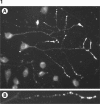Seeding neuritic plaques from the distance: a possible role for brainstem neurons in the development of Alzheimer's disease pathology
- PMID: 18322404
- PMCID: PMC2562573
- DOI: 10.1159/000113716
Seeding neuritic plaques from the distance: a possible role for brainstem neurons in the development of Alzheimer's disease pathology
Abstract
Background and objective: Our goal is to obtain insight into the causes of the pathological lesions in Alzheimer's disease (AD). It is thought that the beta-amyloid (Abeta) deposits within the cerebral cortex and hippocampus of AD brains are initiated by a 'bad seed' of oligomeric Abeta. The origin of this seed is unknown. Here, we focused on the events that might trigger the formation of neuritic plaques, aiming to explain how these plaques form in cortical and hippocampal regions.
Methods and results: Using immunocytochemical and biochemical methods, we showed that brainstem-derived, neuronal cells (CAD)--but not cortical or hippocampal neurons--show large amounts of Abeta accumulated at the terminals of their processes. This is similar to what is believed to occur in brain neurons, in the early phases of AD. CAD cells that contain Abeta accumulations also concentrate beta-secretase at process terminals. We show that, while the anterograde transport of small vesicles is not significantly affected, the mitochondrial transport is perturbed in CAD cells that contain Abeta accumulations. We further show that intracellular, neuritic Abeta accumulations may become extracellular upon neurite degeneration, thus providing the initial 'bad seed' of Abeta oligomers that triggers further aggregation of extracellular proteins.
Conclusion: We propose that brainstem neurons, known to send projections throughout the brain, could provide the 'bad seed' of Abeta that nucleates plaques in the cerebral cortex and hippocampus of AD brains.
2008 S. Karger AG, Basel
Figures




Similar articles
-
Droplet Degeneration of Hippocampal and Cortical Neurons Signifies the Beginning of Neuritic Plaque Formation.J Alzheimers Dis. 2022;85(4):1701-1720. doi: 10.3233/JAD-215334. J Alzheimers Dis. 2022. PMID: 34958037
-
Beta-secretase-1 elevation in transgenic mouse models of Alzheimer's disease is associated with synaptic/axonal pathology and amyloidogenesis: implications for neuritic plaque development.Eur J Neurosci. 2009 Dec;30(12):2271-83. doi: 10.1111/j.1460-9568.2009.07017.x. Epub 2009 Dec 10. Eur J Neurosci. 2009. PMID: 20092570 Free PMC article.
-
Pathological changes induced by Alzheimer's brain inoculation in amyloid-beta plaque-bearing mice.Acta Neuropathol Commun. 2022 Aug 16;10(1):112. doi: 10.1186/s40478-022-01410-y. Acta Neuropathol Commun. 2022. PMID: 35974399 Free PMC article.
-
Neuritic Plaques - Gateways to Understanding Alzheimer's Disease.Mol Neurobiol. 2024 May;61(5):2808-2821. doi: 10.1007/s12035-023-03736-7. Epub 2023 Nov 8. Mol Neurobiol. 2024. PMID: 37940777 Free PMC article. Review.
-
Ferroptosis and pathogenesis of neuritic plaques in Alzheimer disease.Pharmacol Rev. 2025 Jan;77(1):100005. doi: 10.1124/pharmrev.123.000823. Epub 2024 Nov 22. Pharmacol Rev. 2025. PMID: 39952690 Review.
Cited by
-
A persistent stress response to impeded axonal transport leads to accumulation of amyloid-β in the endoplasmic reticulum, and is a probable cause of sporadic Alzheimer's disease.Neurodegener Dis. 2012;10(1-4):60-3. doi: 10.1159/000332815. Epub 2011 Dec 7. Neurodegener Dis. 2012. PMID: 22156573 Free PMC article.
-
Glutaminyl cyclase contributes to the formation of focal and diffuse pyroglutamate (pGlu)-Aβ deposits in hippocampus via distinct cellular mechanisms.Acta Neuropathol. 2011 Jun;121(6):705-19. doi: 10.1007/s00401-011-0806-2. Epub 2011 Feb 8. Acta Neuropathol. 2011. PMID: 21301857 Free PMC article.
-
The amyloid-beta precursor protein is phosphorylated via distinct pathways during differentiation, mitosis, stress, and degeneration.Mol Biol Cell. 2007 Oct;18(10):3835-44. doi: 10.1091/mbc.e06-07-0625. Epub 2007 Jul 18. Mol Biol Cell. 2007. PMID: 17634293 Free PMC article.
-
The mechanistic link between selective vulnerability of the locus coeruleus and neurodegeneration in Alzheimer's disease.Acta Neuropathol. 2021 May;141(5):631-650. doi: 10.1007/s00401-020-02248-1. Epub 2021 Jan 11. Acta Neuropathol. 2021. PMID: 33427939 Free PMC article. Review.
-
Genetic architecture of hippocampus subfields volumes in Alzheimer's disease.CNS Neurosci Ther. 2024 Mar;30(3):e14110. doi: 10.1111/cns.14110. Epub 2023 Feb 8. CNS Neurosci Ther. 2024. PMID: 36756718 Free PMC article.
References
-
- Selkoe DJ. Alzheimer's disease: genes, proteins, and therapy. Physiol Rev. 2001;81:741–766. - PubMed
-
- Harper JD, Lansbury PT., Jr Models of amyloid seeding in Alzheimer's disease and scrapie: mechanistic truths and physiological consequences of the time-dependent solubility of amyloid proteins. Annu Rev Biochem. 1997;66:385–407. - PubMed
-
- Muresan Z, Muresan V. A phosphorylated, carboxy-terminal fragment of β-amyloid precursor protein localizes to the splicing factor compartment. Hum Mol Genet. 2004;13:475–488. - PubMed
Publication types
MeSH terms
Grants and funding
LinkOut - more resources
Full Text Sources
Medical
Research Materials
Miscellaneous

